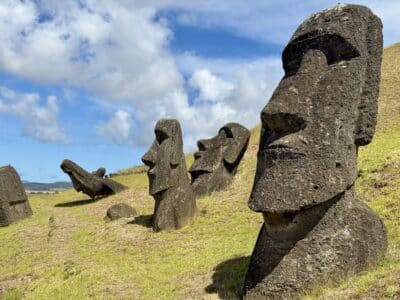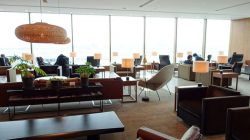American drops service to Haneda airport, freeing up a slot for bidding carriers
In October, American Airlines announced a major international expansion to Asia from its Dallas/Ft. Worth hub to Shanghai and Hong Kong, slated to begin in summer 2014. Along with this announcement, the airline also quietly informed the public that it was withdrawing services from Tokyo Haneda airport effective December 1, 2013. This was a route American had flown from its New York JFK hub off-and-on since 2011, but the flight suffered from inconvenient arrival and departure times allocated to them by governmental authorities at the landing slot-restricted Haneda airport. Consequently, the route was unsuccessful in attracting enough high-yielding traffic to turn a profit, meriting its ultimate cancellation.
With a freed-up landing slot available for other bidders, United Airlines almost immediately stepped forward to submit an application to the US Department of Transportation to absorb the slot and launch a flight from its San Francisco hub to Tokyo Haneda in summer 2014. Of the four US-based carriers that serve the Asia – Pacific market, United is the only carrier that has not received a route awarding to access the coveted Haneda airport. Aside from American’s recently relinquished service to HND, Delta currently flies from Los Angeles and Seattle to Haneda, and Hawaiian Airlines offers a service from its Honolulu base to Haneda. Both United and its merger partner Continental had both tried unsuccessfully to bid for rights to fly to Haneda back in 2010, when the first round of awardings took place.
For 2014, Hawaiian Airlines is the other carrier to have submitted an application for the Haneda landing slot, proposing an additional nonstop service to Haneda from the city of Kona, located on Hawaii’s Big Island. Per Hawaiian’s statement on its application, the proposed service would link Hawaii’s second busiest Japanese Origin and Destination (O&D) market with Haneda.
Both carriers have proposed the following schedules for their respective SFO-HND and KOA-HND flights:
United
UA875 SFO–HND 1920-2210 772
UA876 HND–SFO 0005-1750 772
Hawaiian
HA432 KOA-HND 1750-2200 332
HA431 HND-KOA 2355-1245 332
US carriers still ambitious to secure access to HND despite history of mixed results
The fight to win access to Haneda has been a long and painful road for virtually all of the players involved. Located within 30 minutes of central Tokyo, Haneda is much more convenient for business passengers seeking direct access to Tokyo’s business district over the more globally-served Narita airport, located 37.5 KM way from Tokyo Station versus a mere 8.7 KM for Haneda. Hoping to target the higher yielding origin-and-destination traffic from points such as New York and Los Angeles to Tokyo, and leverage connections on local Japanese carriers such as Japan Airlines and All Nippon Airways with their sizable bases at Haneda, the US airlines saw massive potential at Haneda.
However, timing was unfortunate, and results have been primarily mixed-to-poor since the get-go. The 2011 earthquake in Japan took a devastating toll on US – Japan demand flows, resulting in temporary suspensions and capacity reduction. Even as the market rebounded in subsequent months, the flights arrived and departed into Haneda at highly inconvenient hours, creating a headache for local travelers. For American, the timings were suitable on the New York end of the route, with the outbound flight leaving JFK in the early evening and the inbound arriving early in the morning, enabling a full day’s work for business travelers. Conversely, on the Haneda side of the route, the flight landed from JFK late in the evening and departed early the following morning. This did not facilitate connections without a lengthy layover, and also did not permit passengers to use public transit services to Central Tokyo as the trains offered limited or no services at those after-hour times.
Per CAPA route data, load factors on American’s JFK-HND flight were fairly erratic. In January 2013, for example, AA carried a load factor of approximately 57%. This figure jumped to 80% in March, but dropped down to 40% in April, then back up to 82% in May.
As such, American’s best alternative was to simply withdraw from the route and further de-emphasize the need to concentrate on Japan as the primary anchor of its Asian network coverage. Rather than move the flight to reinstate a New York JFK – Tokyo Narita nonstop (which it had pulled in summer 2012 in an effort to boost the visibility of the JFK-HND route), its joint venture partner, Japan Airlines (JAL), is instead launching a second daily service from NYC to Japan using the more cost-efficient Boeing 787 Dreamliner. This substitution will allow OneWorld to maintain a necessary level of capacity in the NYC-TYO corridor while also optimizing yields and reducing costs. American and JAL share revenue and costs on their transpacific routes and coordinate schedules and capacity. Within the New York – Tokyo sector, both carriers compete against Delta Air Lines, United and All Nippon Airways for market share.
Meanwhile, Delta has also had lacklustre success at Haneda, initially receiving two slot allocations to fly from Los Angeles and its Detroit base to Haneda in 2011, alongside American’s flight from JFK and Hawaiian’s service from Honolulu to Haneda (there were four allocations ultimately rewarded in total). Even with massive feed into its Detroit hub, Delta was unable to make the flight perform to expectations.
As I previously wrote:
Delta quickly down-gauged capacity on the DTW-HND and LAX-HND routes from 747s and 777s to Airbus A330s, citing sub-par performances from the ill-conceived times. Eventually, the situation became so dismal that Delta relinquished its Detroit – Haneda slot and re-applied with the US DOT to move the allocation to launch from its Seattle hub, which, to the surprise of many, was actually granted by the DOT.
With the aircraft sitting on the ground overnight in Tokyo, American had to allocate two 777s to fly an unprofitable route. For Delta, even with the massive feed it commands from its Detroit hub, the same issue with resources ultimately plauged the success of its DTW-HND flight. Hence, Delta was willing to make a second attempt from another west coast gateway at Seattle, which can capably fly transpacific with a single dedicated aircraft as opposed to Detroit, Minneapolis, Atlanta, or any of its other inner-coastal hubs.
United and Hawaiian are more optimistic about their chances for success
In its application, United stated that its proposal provides the biggest consumer benefits by offering US carrier service from its SFO gateway to Haneda, one of the nation’s top international city pairs. United also maintains that its SFO hub is best positioned of all of the existing US cities with a link to Haneda (over Honolulu, Seattle and Los Angeles) to maximize feed from 33 California and Western US markets, providing a 1-stop service for millions of US consumers to Haneda.
Another advantage that United is emphasizing is that with the arrival of additional 787s in its fleet, the carrier will have the slack to adjust capacity seasonally if required. The local business market to Japan continues to suffer from the weakened Yen, and both Delta and United reported their second consecutive year of yield and R/ASM declines in their respective Japanese networks.
Still, neither carrier seems intent on giving up on Japan, believing instead that the right fix is to shift around capacity rather than remove it entirely. United is cancelling its Seattle – Tokyo flight and moving the aircraft to launch a second daily Houston – Tokyo flight in its place. Delta is axing its San Fransico – Tokyo Narita route, which it inherited from its merger with Northwest, and instead is up-gauging its Seattle – Tokyo Narita flight to a 747-400.
These movements have shown that US carriers are becoming more conservative in their methodology when it comes to deploying capacity to Japan. Previously, the strategy centered around creating more point-to-point opportunities and offering a multitude of options for passengers hailing from various hubs around the country. Delta attempted a flight from its Salt Lake City hub to Tokyo a few years ago, which was short-lasting. It is also pulling the chord on a route from Seattle to Osaka in a few months, another route it inherited from its merger with Northwest Airlines.
In contrast, it appears that the more effective model that US carriers are adopting for the cooling Japan market is adding more seats to existing routes, as evidenced by United’s capacity at Houston and benefitting from its JV partner All Nippon Airways’ second daily additional frequency to Chicago O’Hare, which started in June 2013.
In fact, it also appears that same strategy is being implemented in Canada, where both ANA and Air Canada have announced, within three days of each other, two new daily routes from both Vancouver and Toronto to Tokyo Haneda. Both airports have existing nonstop service to Tokyo Narita on Air Canada, which also participates in a joint venture agreement with Star Alliance partner All Nippon Airways across the Pacific, with both carriers having anti-trust immunity. Toronto will be linked to Haneda via one of Air Canada’s newly delivered 787-800 Dreamliners, and Vancouver will receive a daily 767 service operated by All Nippon.
Schedule as follows:
Air Canada (Toronto – Haneda) effective July 1, 2014
AC 005 YYZ–HND 13:00-14:55 +1
AC 006 HND–YYZ 17:40-16:40
All Nippon (Vancouver – Haneda) effective March 30, 2014
NH116 HND2155 – 1455YVR 763 D
NH115 YVR1655 – 1905+1HND 763 D
Interestingly, the key difference here is that the Canadian services to Haneda will both arrive and depart Haneda airport during daylight hours, eliminating a constraint that the US carriers currently face. The liberalization of Canada’s air services agreement with Japan was a major catalyst to enabling this development.
The timeline is approaching, and United is likely to emerge as the victor
Applications for the Haneda services were filed on November 26, 2013, and answers are expected to be delivered today. Replies to the decision awarding will need to be submitted by December 16.
In my view, both carriers are submitting strong cases for their individual requests. Hawaiian, by far, has had the most success of all the US carriers on its Haneda operations, buoyed by a strong origin and destination feed from the Islands to Japan, as well as enjoying the advantage of geographic proximity to scale back on operating costs. HA has also applied for KOA-HND before and, while its submission was denied, tenacity will be looked upon favorably.
However, some things also work against Hawaiian as well. In particular, the carrier has expanded aggressively across the Asia-Pacific market over the past few years, adding capacity to secondary cities in Japan, such as Sendai, Sapporo and Fukuoka, as well as service to Brisbane, Auckland, Taipei and has Beijing in the pipeline for a 2014 launch. Unfortunately, this expansion has taken an adverse impact on HA’s unit revenues, which fell 6.3% for the first nine months of 2013, according to CAPA. These markets will need more time to mature before they can show signs of long-term success.
United presents a stronger case for its Haneda flight proposal. The power of its SFO hub continues to present a formidable challenge for Delta and American to emulate. Even though O&D volumes out of Hawaii are larger, San Francisco still generates plenty of high-yielding traffic, and can rely on O&D alone to fill up a daily 777, or 787, if needed, with healthy load factors in the front and back cabins. Throw in plenty of domestic connections and the route is a slam dunk.
It also helps that United is the sole US carrier that has not been granted access to HND before, and the DOT will look favorably upon this. With each passing day that Delta offers a flight to Haneda from two of its West Coast hubs, while United does not, presents a problem for the world’s largest carrier. In the end, United needs this one badly, moreso than Hawaiian, and likely will get its chance.




